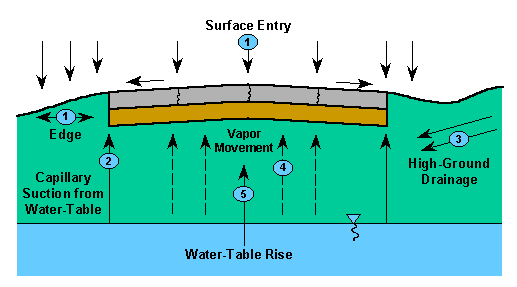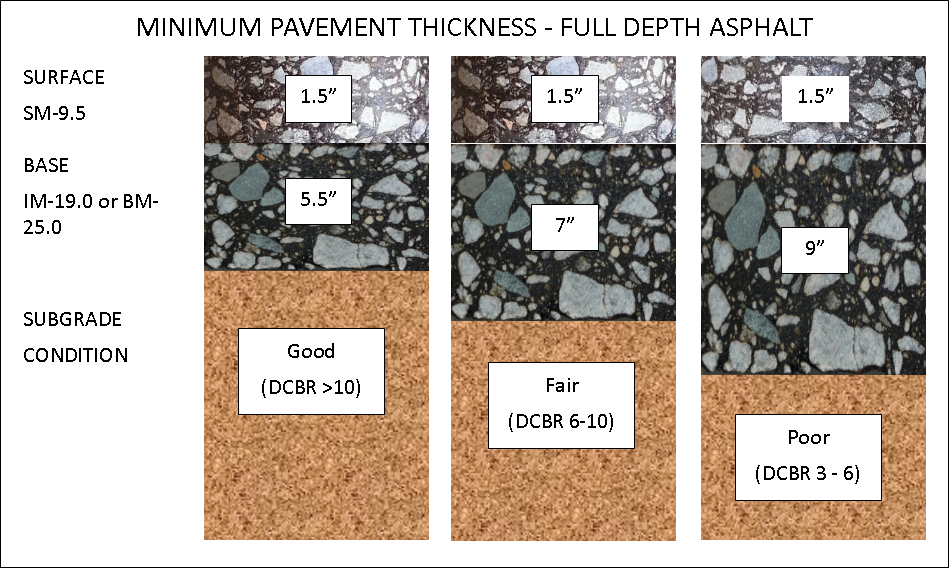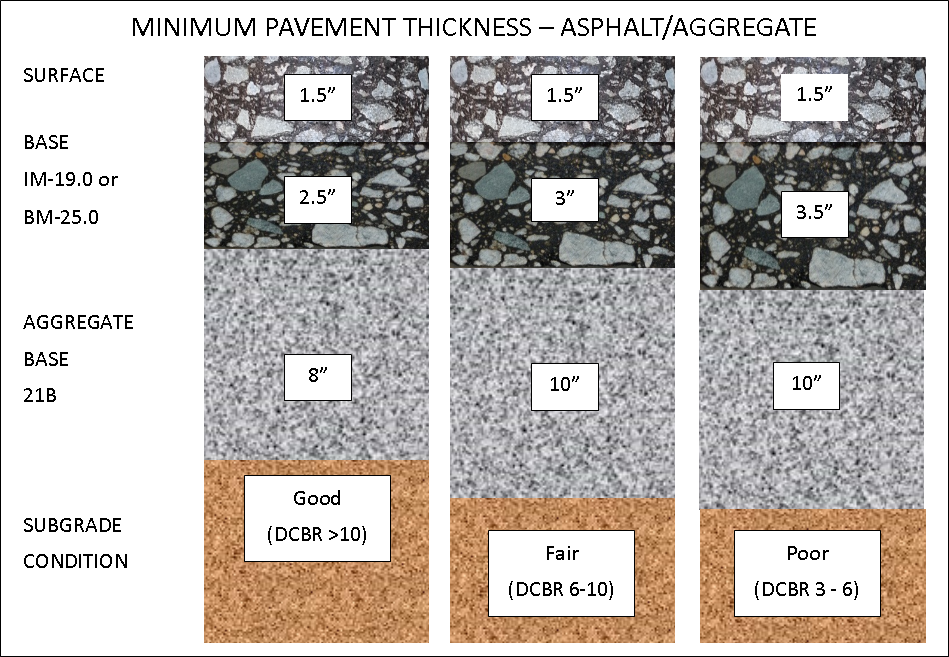 Please note – Industrial drives come in all lengths, widths, loading conditions, and uses, as do truck and bus terminal areas. This chapter addresses only the basics of their proper design principals and a few special considerations. Both industrial drives and terminal areas generally incorporate heavy pavement loading; therefore, it is critical that they be properly designed. Asphalt concrete is well suited for this type of application because it permits the versatility of varied pavement designs while maintaining maximum pavement strength.
Please note – Industrial drives come in all lengths, widths, loading conditions, and uses, as do truck and bus terminal areas. This chapter addresses only the basics of their proper design principals and a few special considerations. Both industrial drives and terminal areas generally incorporate heavy pavement loading; therefore, it is critical that they be properly designed. Asphalt concrete is well suited for this type of application because it permits the versatility of varied pavement designs while maintaining maximum pavement strength.
 An industrial driveway and truck parking areas must be properly design and constructed in order to perform adequately. This page will give general guidance on building industrial driveways and truck/bus parking areas. Because of the heavy loads associated with the vehicles that use these facilities, proper site investigation, materials testing and pavement design should be completed by a licensed engineer. Even with the complexities of these pavements, asphalt concrete can provide the versatility and strength needed to provide a long service life.
An industrial driveway and truck parking areas must be properly design and constructed in order to perform adequately. This page will give general guidance on building industrial driveways and truck/bus parking areas. Because of the heavy loads associated with the vehicles that use these facilities, proper site investigation, materials testing and pavement design should be completed by a licensed engineer. Even with the complexities of these pavements, asphalt concrete can provide the versatility and strength needed to provide a long service life.
 Depending on the use of the truck or bus parking areas, proper design and construction will mitigate most full depth pavement failures. The main cause of pavement failure in parking areas is fuel spillage. Asphalt concrete is a petroleum-based product; when other petroleum-based products are spilled on asphalt concrete, then the asphalt concrete softens and loses strength. To prevent the damage from these spills, the parking area should be protected with a solvent resistant seal coat. This coat should be applied no less than 30 days after paving and preferably between 60 and 90 days after paving. This will allow the asphalt concrete to “cure” and harden.
Depending on the use of the truck or bus parking areas, proper design and construction will mitigate most full depth pavement failures. The main cause of pavement failure in parking areas is fuel spillage. Asphalt concrete is a petroleum-based product; when other petroleum-based products are spilled on asphalt concrete, then the asphalt concrete softens and loses strength. To prevent the damage from these spills, the parking area should be protected with a solvent resistant seal coat. This coat should be applied no less than 30 days after paving and preferably between 60 and 90 days after paving. This will allow the asphalt concrete to “cure” and harden.
The following information can be used to assist in the pavement design and construction process.
Special Considerations
Although the design chart in this chapter provides the pavement designer an alternate between asphalt concrete and crushed aggregate for a portion of the base, a multilayered asphalt concrete pavement is still recommended over both bases due to the extreme pavement loading conditions that usually exist on industrial drives and bus and truck terminal parking areas. For these types of pavements, Virginia Department of Transportation asphalt concrete mix types BM-25D and IM-19D or E are recommended for all pavement layers (excluding surface courses) because of their superior strength and rut resistance. In addition to these VDOT has developed special high strength mixes for use in severe loading applications like truck terminals, industrial drives, bus lanes, and intersections.
With the exception of improper design, fuel spillage is the most common cause of pavement failure and deterioration associated with areas  where truck and bus parking and unloading takes place. Because asphalt concrete contains asphalt cement, a petroleum product, gasoline, diesel fuel, and lubricating oils spilled on the pavement can soften the asphalt. Therefore, it is strongly recommended that these pavements be sealed with a coal tar emulsion to prevent the intrusion of these solvents. Applications, however, should not be made until a minimum of 30 days, preferably 60-90 days, after placement of the pavement. This will permit all the solvents contained in the asphalt concrete to evaporate.
where truck and bus parking and unloading takes place. Because asphalt concrete contains asphalt cement, a petroleum product, gasoline, diesel fuel, and lubricating oils spilled on the pavement can soften the asphalt. Therefore, it is strongly recommended that these pavements be sealed with a coal tar emulsion to prevent the intrusion of these solvents. Applications, however, should not be made until a minimum of 30 days, preferably 60-90 days, after placement of the pavement. This will permit all the solvents contained in the asphalt concrete to evaporate.
As is the case in planning all types of roadway facilities, it is absolutely essential that maximum safety features be built into these type facilities. Right angle intersections provide better visibility in all directions for the driver, as well as shorter crossing distances. The installation of underground wiring for electric and telephone utilities is desirable for safety and aesthetics.
Design Considerations
The two most important considerations in designing a pavement are traffic and drainage. If either is not adequately accounted for in the pavement design, the pavement structure will either be over-designed (and money wasted) or under designed (and result in premature and continual maintenance).
The pavement thicknesses given in this manual are minimum compacted thicknesses. Any reduction of the pavement thickness values shown for base or surface may cause severe pavement failure and/or a shorter pavement life.
Traffic Analysis
All asphalt pavements must be designed using proper loading data to ensure adequate pavement performance. The Industrial Pavements category covers a wide range of pavement types and loading ranging from heavy industrial truck terminals to container unloading docks. Traffic levels and pavement loadings will depend on the type of facility and must be accurately accounted for during the pavement design process.

CAUTION: The effects of truck traffic on pavement life can be dramatic. Test results have shown that a single, fully loaded, 80,000-pound truck can cause the equivalent in pavement wear of 9,600 automobiles. While these test results may only approximate pavement wear caused by heavy vehicles, they do illustrate why estimating traffic type, weight, and number is important to determining the proper asphalt pavement design.
This Design Manual considers industrial drives and terminal parking areas to be heavy duty pavements with traffic, both present and future, primarily heavy trucks and buses. Any deviation from this assumption will require adjustments to the pavement designs shown in the table.
 The owner of an industrial facility should know how many heavy and what types of trucks will be using the facility. This information combined with the soil strength information will determine the final pavement thickness.
The owner of an industrial facility should know how many heavy and what types of trucks will be using the facility. This information combined with the soil strength information will determine the final pavement thickness.
The same approach can be used with bus facilities. While they do not weigh as much as a 5 axle truck, they do impart a heavy load on the pavement. By knowing the bus weight, the number of buses expected to use the facility daily, weekly or monthly, and the soil strength, a pavement structure can be designed.
Too often pavements are designed considering the trucks moving at a certain speed, but it is the slow turning movements or being stationary that cause result in failures if not properly accounted for in asphalt mix selection and pavement design.
Drainage
Adequate pavement drainage is of great importance to all pavement designs. If the subgrade under the pavement becomes saturated, it will lose strength and stability and make the overlying pavement structure susceptible to break up under imposed loads. Both surface and subsurface drainage must be considered. All drainage must be carefully designed and should be installed in the construction process as early as is practicable.

The pavement should also be constructed in a manner that will not permit water to collect at the pavement edge and provisions should be made to intercept all groundwater from springs, seepage planes, and streams. When used, curb and gutter sections should be set to true line and grade. Marshy areas will require special consideration and should be addressed during the planning stage.
Drainage impacts pavement performance when the subgrade materials and pavement layer materials are saturated and lose strength. Water that falls on the pavement surface must be drained to curb and gutter systems or ditches. Water that penetrates the pavement from the surface; infiltrates from the sides of the road, or rises from under the pavement should not be allowed to compromise the overall strength.
To account for surface water drainage, it is important that the road be constructed with a crown or cross slope. Typically, a crown is placed in the center of the road and the pavement is sloped 2% in each direction. Occasionally, the pavement will be super-elevated where one side of the road is higher than the other. In either case, the pavement must be sloped to keep water from ponding on the surface.

For subsurface water, the approach to address varies based on the project. In some situations, underdrains are placed to intercept water that may flow under a pavement. This water is then allowed to flow out into a ditch or is put in a stormwater system. In many cases where the subgrade becomes weaker due to water, the subgrade is stabilized with a binding agent, removed and replaced with a stronger material, covered with a stabilization fabric prior to placing the next pavement layer or the next pavement layers are made thicker.
Soil Support
The ability of the native subgrade soil to support loads transmitted through the pavement is one of the most important factors in determining pavement thickness. Prior to construction or developing the project plans, the subgrade should be sampled and tested for strength. The primary strength parameter for subgrade soil is the California Bearing Ratio or CBR and quantifies how well the soil can withstand traffic loads. The CBR test provides a simple and dependable index of a soil’s load-bearing capacity, the lower the value, the less strength the soil has. It is widely used by many highway departments as well as other governmental agencies on both the state and federal levels.
Overall, all projects should be sampled and tested by a qualified engineering firm. The number of samples will depend on the length of the road and the changes in soil type. VDOT testing manuals can be consulted for recommended testing rates.
However, the designer should be aware of the limitations of using averaged CBR values in determining soil support data. Up to one-third of the soil samples used to compute an average CBR will be below that value.
Example:
Nine CBR samples are taken on a proposed subdivision street in Richmond and their values are as follows:

The average CBR value for these samples is 10. However, samples #3, 7 and 8 were well below 10. If the pavement is designed based on an average CBR value of 10, pavement failure in the areas of test samples 3, 7 and 8 can be expected.
This Manual recommends a Design CBR value of two-thirds (2/3) the actual average CBR value be used in selecting pavement thickness (the Vaswani design method used by The Virginia Department of Transportation also uses a design value of two thirds (2/3) the average CBR value). This will help assure the adequacy of the pavement design.
In general, a design CBR value of 3 or less indicates a poor soil. Soils with this value should be removed to a depth of 12 inches to 18 inches and replaced with a stronger material, or stabilized with additives such as lime or cement to a depth between 6 inches and 12 inches.
ASTM Standard Test Method D 1883
Subgrade Preparation
Because the subgrade must serve both as a working platform to support construction equipment and as the foundation for the pavement structure, it is most important to see that it is properly compacted and graded. Laboratory tests to evaluate the load supporting characteristics of subgrade soil are required. Test data for the area may be available from the Virginia Department of Transportation’s local office.
All underground utilities should be protected or relocated prior to grading.
All topsoil should be removed and low-quality soil must be improved by adding asphalt or other suitable admixtures such as lime or granular materials.
The areas to be paved should have all rock, debris, and vegetation matter removed. Grading and compaction of the area should be completed in such a manner as to prevent yielding areas or pumping of the soil. The subgrade should be compacted to a uniform minimum density of 95% of the maximum theoretical density.
Should a weak spot be discovered, the material should be removed and replaced with either six inches (6″) compacted crushed stone or three inches (3″) compacted asphalt concrete. In case of extremely poor subgrade, it may be necessary to remove the upper portion of the subgrade and replace it with the selected material. When finished, the graded subgrade should not deviate from the required grade and cross section by more than one-half inch (1/2”) in ten feet (10′).
Base Construction (Asphalt)
Prior to placement of the asphalt concrete base course, the subgrade should be graded to the established requirements, adequately compacted, and all deficiencies corrected. The asphalt concrete base course should be placed directly on the prepared subgrade in one or more lifts, spread, and compacted to the pavement thickness indicated on the plans or established by the owner. Compaction of asphalt mixtures is one of the most important construction operations contributing to the proper performance of the completed pavement, regardless of the thickness of the course being placed. This IS why it is so important to have a properly prepared subgrade against which to compact the overlying pavement. The asphalt concrete should meet the Virginia Department of Transportation’s specification for the mix type specified.
Base Construction (Aggregate)
The subgrade must be graded to the required contours and grade in a manner that will ensure a hard, uniform, well-compacted surface. All subgrade deficiency corrections and drainage provisions should be made prior to constructing the aggregate base.
The crushed aggregate base course should consist of one or more layers placed directly on the prepared subgrade; spread, and compacted to the uniform thickness and density as required on the plans or established by the owner. Absolute minimum crushed aggregate thickness is six inches (6″). All crushed aggregate material should be of Virginia Department of Transportation’s approved type and suitable for this type of application.
Tack Coat
Prior to placement of successive pavement layers, the previous course should be cleaned and, if needed, a tack coat of diluted emulsified asphalt applied. If the previous course is freshly placed and thoroughly clean, the tack coat may be eliminated.
Asphalt Surface Course
Material for the surface course should be asphalt concrete placed in one or more lifts to the true line and grade as shown on the plans or set by the owner. The asphalt concrete should conform to Virginia Department of Transportation’s specifications for the selected mix. The asphalt surface should not vary from established grade by more than one-quarter inch (1/4”) in ten feet (10′) when measured In any direction. Any irregularities in the surface of the pavement course should be corrected directly behind the paver. Rolling and compaction should start as soon as the asphalt concrete can be compacted without displacement and continued until thoroughly compacted and all roller marks disappear.
Curb and Gutter
Designed to provide roadway drainage, curb and gutter also delineate the roadway edge. Gutter widths vary from one (1’) to two (2’) feet, with a one and-one-half (11/2’) foot width being most common. Vertical curbs range between five (5”) and eight (8”) inches in height, with a six (6”) inch high curb preferred.
One of the most common errors in pavement design is not specifying the appropriate grades to ensure that water does not collect on the pavement. Many parking areas and industrial drives have the elevation of the pavement below that of the curb and gutter causing the pavement to carry runoff. As water is the biggest enemy of any pavement, these “dry curbs” will result in poor pavement performance and/ or shorter pavement life.
Pavement Structure
The pavement structure and materials used will change as a function of subgrade strength and construction approach. Some projects will use full-depth asphalt (i.e., asphalt placed directly on compacted subgrade) and some will use an aggregate base placed on compacted subgrade. The aggregate base will be covered with multiple layers of asphalt. The table below is suggested minimum pavement designs. Each layer is the compacted thickness. At no time should less than 6 inches of an aggregate subbase layer be used.
Table 1 – Full-Depth Asphalt Pavement

Table 2 –Asphalt with Aggregate Sub-Base Pavement

Notes:
- Design CBR is defined as 2/3 of the soaked CBR value.
- VDOT Specifications for SM-9.5 and BM-25.0 can be found in Section 211 of the VDOT, Road and Bridges Specification Book.
- VDOT Specifications for 21B can be found in Section 208 of the VDOT, Road and Bridges Specification Book.
- (1) Due to the heavy loads applied to the surface, a stronger asphalt binder is recommended. A PG 64E-22 meeting the VDOT specifications outlined in Section 211 of the 2016 VDOT Road and Bridge Specifications Book is typically used in these applications. Given the nature of PG 64E-22, little to no handwork by the paving crew should be performed. This material works best for open pulls by the paver. If handwork is needed, then PG 64H-22 should be used. Consult your local paving contractor for assistance in determining the amount of handwork.
- (2) Due to the heavy loads applied to the pavement, a stronger asphalt binder is recommended. A PG 64H-22 or equivalent that meets the VDOT specifications outlined in Section 211 of the 2016 VDOT Road and Bridge Specifications Book is typically used in these applications.
Future Maintenance Considerations
In time, pavement failures may occur due to settlement or weakening of the soil or aggregate base layers. These will result in localized failures or potholes. To repair these failures, the area impacted should be cut out and the pavement material removed to the subgrade. The subgrade material may need to be removed and replaced or simply recompacted. Finally, the removed pavement material should be replaced with new asphalt concrete or a permanent asphalt patching material.
As asphalt ages, shrinkage cracks will develop. Individual transverse and longitudinal cracks should be sealed with an asphalt-based material to reduce the amount of water infiltrating the underlying pavement layers. If the cracking is extensive, then the pavement can be overlaid with a new AC surface or milled and replaced with a new AC surface. Overlaying can be performed on areas without curb and gutter. For areas with curb and gutter, milling may be needed to maintain surface drainage. While edge milling can be performed, typically 4 to 6 feet in width at the edge of the pavement, full pavement milling is recommended in order to keep proper cross-slope.
References
- 2016 VDOT Road and Bridges Specifications
- VDOT Special Provisions to the 2016 Road and Bridges Specifications
- VAA Pavement Design Manual